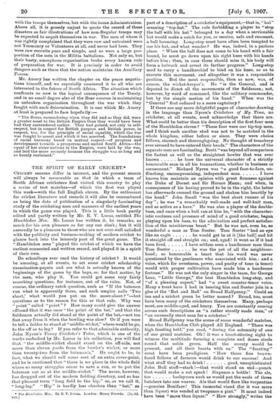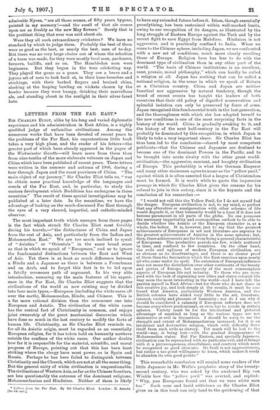THE SPIRIT OF EARLY CRICKET.*
CRICKET seasons differ in interest, and the present season will always be memorable as that in which a team of South African cricketers first visited this country to play a series of test matches—of which the first was played this week—with the full English eleven. By the enthusiast for cricket literature and records it will also be remembered as being the date of publication of a singularly fascinating study of the cricketing men and manners of the earliest years in which the game was played. This is a little book partly edited and partly written by Mr. E. V. Lucas, entitled The Hambledon Hen. Mr. Lucas has written it, he remarks, as much for his own pleasure as for any one else's; but it will assuredly be a pleasure to those who are not over-well satisfied with the publicity and business-making of modern cricket to glance back into the leisurely past of the great game. The "Hambledon men" played the cricket of which we have the earliest connected and written record, and played it in a spirit of their own.
Do schoolboys ever read the history of cricket ? It would be amusing, at all events, to set some cricket scholarship examination-papers and see what is actually known of the beginnings of the game by the boys, or, for that matter, by the men, who play it. You could get some very fairly searching questions, for instance, out of the rules. Not, of course, the ordinary catch question, such as "If the batsmen run what is apparently three, and each umpire calls Two short,' what would you put on the score-sheet ? "—but questions as to the reason for this or that rule. Why was " point " called " point " ? How many could give the answer offhand that it was once "the point of the bat," and that the fieldsman actually did stand at the point of the bat,—not ten feet away from it when the bowling was slow? Or if you were to tell a fielder to stand at "middle-wicket," where would he go, to the off or to leg ? If you refer to that admirable authority, John Nyren's Young Cricketers Tutor, which is one of the works embodied by Mr. Lucas in his collection, you will find that "the middle-wicket should stand on the off-side, not more than eleven yards from the bowler's wicket, or more than twenty-two from the batsman's." He ought to be, in fact, what we should call some sort of an extra cover-point, and be is cautioned that "there is no place in the whole field where so many struggles occur to save a run, or to put the batsman out as at the middle-wicket." The name, however, has dropped out of the modern fielding directory, and so has that pleasant term "long field to the hip," or, as we call it, "long-leg." "Hip" is hardly less obsolete than "hat," as * The Hamttedon Hen. By E. V. Lucas. Loudon: Henry Frowde. [2s. 6d. net. J part of a description of a cricketer's equipment,—that is, "hat" meaning "top-hat." The rule forbidding a player to "stop the ball with his hat" belonged to a day when a serviceable hat would make a catch for you, or receive, safe and resonant, a ball bouncing. Long-stop must have often been tempted to use his hat, and what wonder ? He was, indeed, in a parlous place. "When the ball does not come to his hand with a fair bound, he must go down upon his right knee with his hands before him ; then, in case these should miss it, his body will form a bulwark and arrest its farther progress." Long-stop used to carry a handkerchief to bind on his knee, so as to execute this movement, and altogether it was a responsible position. But the most responsible, then as now, was, of course, the wicket-keeper's. He "is the General, and is deputed to direct all the movements of the fieldsmen; not, however, by word of command, like the military commander, but by the simple motion of his hand." When was the " General " first reduced to a mere captaincy ?
If there are any more delightful pages of character-drawing in the language than Nyren's Cricketers of My Time, no cricketer, at all events, need acknowledge that there are. What could be better than his description of the first four men of the Hambledon eleven ? "These four were our tip-top men, and I think such another stud was not to be matched in the whole kingdom, either before or since. They were choice fellows, staunch and thoroughgoing. No thought of treachery ever seemed to have entered their heads." The characters of the separate men are fascinating. Brett "was beyond all comparison the fastest as well as the straightest bowler that was ever known he bore the universal character of a strictly honourable man in all his transactions, whether in business or amusement." Richard Nyren was "a good face-to-face, un-
flinching, uncompromising, independent man I have known him maintain an opinion with great firmness against the Duke of Dorset and Sir Horace Mann; and when, in consequence of his having proved to be in the right, the latter has afterwards crossed the ground and shaken him heartily by the hand." John Small "was the best short runner of his day "; he was "a remarkably well-made and well-knit man, and as active as a hare." He was also a player of the double- bass, and once when a bull ran at him he, "with the character- istic coolness and presence of mind of a good cricketer, began playing upon his bass, to the admiration and perfect satisfac- tion of the mischievous beast." But he was not, even he, so wonderful a man as Tom Sueter. Tom Sueter "had an eye
like an eagle he would get in at it [the ball] and hit it straight off and straight on; and, egad ! it went as if it had been fired I have seldom seen a handsomer man than Tom Sueter he was the pet of all the neighbour- hood; so honourable a heart that his word was never questioned by the gentlemen who associated with him : and a voice, which for sweetness, power, and purity of tone (a tenor) would with proper cultivation have made him a handsome fortune." He was not the only singer in the team, for George Lear, "Little George," the best Hambledon long-stop, and "of a pleasing aspect," had "a sweet counter-tenor voice. Many a treat have I had in hearing him and Sueter join in a glee at the 'Bat and Ball' on Broad Halfpenny." Could an inn and a cricket green be better named ? Broad, too, must have been many of the cricketers themselves. Many, perhaps most, are middle-aged, and heavy. You are constantly coming across such descriptions as "a rather stoutly made man," or "an unusually stout man for a cricketer."
Broad Halfpenny was the scene of some wonderful matches, when the Hambledon Club played All England. "There was high feasting held," you read, "during the solemnity of one of our grand matches. Oh! it was a heart-stirring sight to witness the multitude forming a complete and dense circle round that noble green. Half the county would be present, and all their hearts with us." The "feasting" must have been prodigious. "How those fine brawn- faced fellows of farmers would drink to our success! And
what stuff they had to drink T good, unsophisticated
John Bull stuff—stark !—that would stand on end—punch that would make a cat speak ! Sixpence a bottle ! The ale, too barleycorn such as would put the souls of three butchers into one weaver. Ale that would flare like turpentine —genuine Boniface! This immortal viand (for it was more
than liquor) was vended at twopence a pint." It must indeed have been "more than liquor." " How strongly," writes the
admirable Nyren, "are all those scenes, of fifty years bygone, painted in my memory !—and the smell of that ale comes upon me as freshly as the new May flowers." Surely that is the prettiest thing that ever was said about ale.
Were they all such extraordinary cricketers ? We have no standard by which to judge them. Probably the best of them were as good as the best, or nearly the best, men of to-day. But there was no very large choice out of whom the selection of a team was made, for they were mostly local men, gardeners, farmers, bailiffs, and so on. The Hambledon men were beginners. But they began in the true cricketing way. They played the game as a game. They are a brave and a joyous set of men to look back at, in their knee-breeches and stockings, with their barked fingers and bruised shins, slashing at the leaping bowling on wickets chosen by the bowler because they were bumpy, drinking their marvellous ale, and standing about in the sunlight in their silver-laced hats.















































 Previous page
Previous page